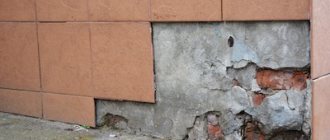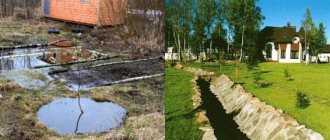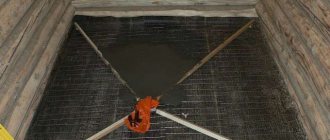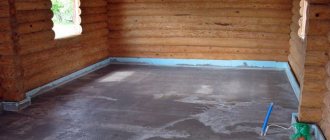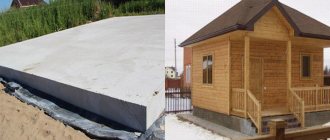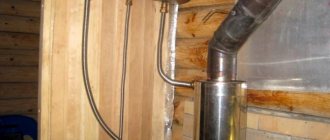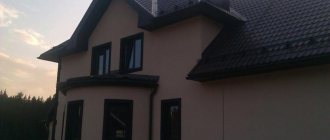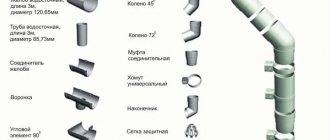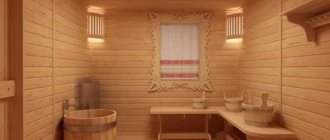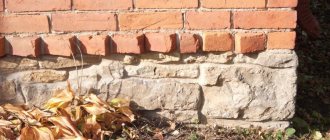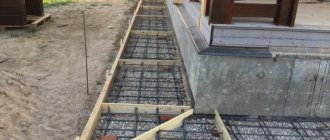Suburban areas with ideal hydrogeological conditions are extremely rare. Mostly they come with natural flaws, which can and should be dealt with. So, to combat groundwater and flood water, wall foundation drainage is constructed. For it to work effectively, you need to know the specifics of the device. Do you agree?
We suggest that you familiarize yourself with the practice-tested rules for constructing wall drainage. Reliable information will be useful to owners who want to make their own water drainage system. The article will also be useful for those who order work from a specialized company in order to control their quality.
We have detailed the step-by-step technology for constructing a system that drains the soil near the base of the house. The article provides recommendations for the operation of drainage. Photo and video applications will provide effective assistance in analyzing a difficult topic.
Foundation contour drainage
To drain water from an already built foundation, wall and ring drains are used.
Their operating principle is the same. The difference is that the wall system is made close to the foundation, and the ring system is made at a distance, usually 1.5-2 meters. Wall drainage is installed in non-filtering soil (clay, loam). Collects surface melt water, which seeps mainly along the wall, and not through impermeable soil.
The ring system is suitable for sandy filter soils. Lowers groundwater levels.
Types of foundation drainage based on pipe laying depth:
- Perfect
. Drainage pipes are laid on a waterproof layer of soil. Used if this layer is shallow. - Imperfect
. Pipes are laid above the waterproof layer if it lies deep.
Elements of wall and ring foundation drainage:
- Drainage trenches.
- Outlet pipes.
- Filter bedding, crushed stone or gravel.
- Filter fabric (geotextile).
- Basement waterproofing.
- Inspection wells.
We'll tell you how these elements are structured and why they are needed.
Drainage trenches
The RMD states that “in soft soils with insufficient load-bearing capacity, the drainage pipe must be laid on an artificial foundation.” This base is a sand cushion. For this we use river sand of 1.5-2 mm size. The thickness of the sand bedding is 50 cm.
Drainage pipes
Typically, corrugated pipes made of low-density polyethylene (HDPE) are used. The standard pipe diameter is 110 mm. The pipes have holes through which water flows. “The dimensions of water intake holes should be selected taking into account the granulometric composition of the soil to be drained” (RMD, 10.9)
Standard polyethylene pipe
Pipes are also used in geotextile filters. They are designed for sandy and loamy soils. These soils are easily washed away by water and can wash into pipes and clog them. The filter traps dirt.
Pipes in geotextiles
Crushed stone for drainage
Crushed stone is needed to filter groundwater so that the pipe holes do not become clogged. The filtering capacity of crushed stone depends on its fraction - the size of one grain. A fraction of 20-40 mm is considered optimal. We use exactly this crushed stone.
Geotextiles
Geotextiles protect crushed stone from erosion and also keep the soil from subsidence. As stated in the RMD, “a geotextile filter must pass water and screen out soil, not be unduly deformed and not limit the access of moisture to the drainage structure, and have bio- and chemical resistance” (RMD, 10.2).
Main characteristics of geotextiles:
- Manufacturing technology
. From one endless thread (monofilament) or from a staple (individual threads 5-10 cm). - Material
. Geotextiles can be needle-punched, thermally bonded or hydro-bonded. - Density
_ Geotextiles with a density of 200 g/m³ are used for drainage systems - Filtration coefficient
. Measured in meters per day.
RMD recommends the use of needle-punched monofilament geotextiles. This geofabric is also used by our company.
Basement waterproofing
To protect the base from moisture, waterproofing membranes are used. They are laid with a 10 cm overlap and connected using self-adhesive bitumen-polymer tape. Fastening is carried out using plastic dowel-nails in increments of 20-25 cm.
Manholes
Needed to monitor the operation of the system and for cleaning. The well consists of a bottom part, a vertical part and a cover. The pipes are either made at the factory or are cut in during installation. Wells are installed along the drainage route every 40-50 m. It is imperative to install wells at turns in the route, as well as when there are level differences.
Storage well
Serves to collect water and drain it into a ditch. Installed at the lowest point of the system. A float pump is placed in the well, which releases water into the ditch.
Foundation drainage device:
- Drainage trenches are dug around the perimeter of the house.
- The trenches are filled with sand. The sand is leveled.
- Geotextiles are laid at the bottom of drainage ditches.
- Granite crushed stone is poured into the geotextile in a layer of 10 cm.
- Pipes are laid on crushed stone. The minimum pipe slope is 2 mm per meter in clay soil, 3 mm per meter in sandy soil.
- Inspection wells are placed at the corners of the route, and a drainage well is installed at the lowest point of the site. Pipes are connected to wells.
- Cover the pipes on top with crushed stone.
- Wrap the edges of the geofabric so that they overlap and completely cover the pipes and crushed stone
- The trenches are filled with sand.
The drainage system cannot be combined with storm sewer. This will lead to storm and melt water washing away sand and crushed stone. It is recommended to do drainage and stormwater in parallel, in one trench.
WHY ARE WELLS NEEDED?
At every 90° turn, inspection wells are installed (sometimes, to save money, they are made at every second corner).
On straight sections they are installed every 50 meters.
They are made from large diameter pipes. You can also find ready-made prefabricated wells on the market.
It is recommended to create a sludge collector at the bottom so that small particles that fall into the pipe can settle in it without clogging the pipe.
To do this, the drainage pipe is fixed at a level of 20 cm above the bottom of the well.
When there is quite a lot of sludge, it is removed with a special pump. The pump is lowered into the well, then, after agitating the water at the bottom with a pressure jet, it is turned on.
Useful tips
It is quite justified to lay out pipes simultaneously with the preparation of inspection wells. This technique will help to avoid mismatch and system inoperability. In all wells they place a container to collect sludge or simply leave space for it. Between the pipe entry point and the base of the well shaft, 0.2-0.25 m is reserved. Backfilling of crushed stone on the sides of the drains is mandatory; Closer to the foundation it is worth raising it to the height of the soil itself.
It is recommended to lift the layer of crushed stone above the drains from 30 cm. Geological textiles are placed above, preventing the mixing of materials and the accumulation of silt. Next, sand is placed, raising it to ground level. It is strictly unacceptable to compact the sand backfill; this will weaken the permeability of the soil to water. Experts and experts advise choosing drainage pipes with a high level of rigidity.
To learn how to install a drainage foundation, see the following video.
Laying technology
For the system to work properly, you need to know how to properly lay the drainage pipe, depending on the type. For each drainage pipe, the installation technology will vary slightly depending on the design. But the initial stage is the same for everyone:
- Develop a drainage scheme: location of pipes, places for wells and revisions.
- Depending on the type of soil, the geological characteristics of the site, the location of groundwater and the required throughput, the size and type of drainage pipe are selected.
- Based on the planned route for wiring drainage pipes on the site, site planning and markings are carried out for excavation work.
The ideal option is when the drainage scheme is developed together with the house design
- They dig trenches. On dense soils with straight walls, on loose soils - with sloped walls, or strengthen them during work. The bottom is made 30 cm wider on both sides of the pipe.
- Level the bottom surface, compact the soil, form a slope towards the drainage well within 0.5-3.0% (minimum 0.5 cm and maximum 3 cm for each meter of length).
- Pour a layer of coarse sand about 15 cm thick and compact it, observing the slope laid down during the formation of the ditch bottom.
Further technology for laying the drainage pipe depends on its design.
Laying a drainage pipe with geotextile, if it does not have a factory winding:
- Geotextiles are laid on top of the sand. The width of the canvas should be sufficient so that the edges can then be brought together.
- Pour a layer of crushed stone (15 cm).
- Lay a perforated pipe and cover it with a layer of crushed stone on top.
- The edges of the geotextile fabric are wrapped and fastened together. As a result, the pipe should be uniformly filled with crushed stone on all sides of about 15 cm, the textiles should run along the sand-crushed stone boundary, and there should be free space left to the walls of the trench.
The principle of drainage is that water seeps through geotextiles, crushed stone and perforation, then flows by gravity through the pipe to the well
- Pour a layer of sand on the sides and top (about 15 cm).
- The removed or imported fertile soil is put back.
If the pipe has a factory winding made of geotextile, then the drainage installation procedure is reduced by two “steps”.
Note! You can buy geotextiles separately, choose perforated pipes without wrapping and wrap them before carrying out work.
When using pipes with a filter layer of polystyrene foam granules and windings, crushed stone is not covered. And if you believe the manufacturer’s advertising video, you don’t even have to fill in the sand.
https://youtube.com/watch?v=DloSGrkFtYA
Types of foundation protection systems
Formative drainage
Constructing a building on clay soil requires protecting the basement from dampness. Foundation drainage in the form of a monolithic slab requires the installation of a special system. It is laid after digging a pit under the building and comes in two types:
- single-layer – sand or crushed stone;
- two-layer - a combination of layers of crushed stone and sand or the addition of a geotextile membrane.
A layer of gravel or crushed stone is poured to a height of 30-50 cm; it should extend beyond the contours of the building. There are drains along the perimeter. If the site has a large volume of formation water, a two-layer system is used, and discharge pipes are additionally laid under a layer of crushed stone.
Formation drainage device
To prevent the drainage layer from flooding, it is covered with a special cloth, an economical option is glassine, a more expensive and effective option is a drainage membrane. This fabric provides a connection between reservoir and wall drainage.
Wall drainage
For buildings with a basement and ground floor, this method will be an indispensable option for removing moisture. If the drainage system is installed after construction is completed, then it is necessary to dig trenches around the perimeter of the building. Their depth must exceed the depth of the foundation. The width is determined by the convenience of doing the work. Before starting work, the basement walls are waterproofed. This step is important to prevent moisture from entering the building. Coating or penetrating insulation is used. The coating option is a liquid bitumen mastic, which is applied to the walls in a layer of 2-4 mm. Penetrating compounds change the structure of concrete and close the pores. A waterproof layer is formed on the surface of the material.
Among the innovative devices for protecting the foundation from excess moisture, drainage membranes have appeared. This is a waterproofing fabric made of dense polyethylene. Spike-like protrusions are created on its surface. They provide free space through which excess moisture flows into the drainage. To improve performance, the material is made multilayer; the membrane is complemented by a non-woven geotextile fabric designed to retain soil particles. The canvas is attached to the foundation wall with plastic dowels, which are driven above the waterproofing layer. The side with the spikes is turned towards the building, the membranes are laid with an overlap, and the seams are sealed with mounting tape.
Another modern way to remove moisture from the foundation is drainage mats. This is a multilayer composite fabric that performs the functions of protection, waterproofing and filter. The material is strong and durable, it does not deform during use. The mats are laid vertically on the foundation walls after applying a layer of mastic waterproofing. During installation, it is necessary to reduce the number of joints by laying the material in one sheet. The junctions with the wall and the seams are taped with waterproof tape. The structure of the mats is designed so that moisture flows through them into the drainage pipes.
Wall drainage device
The technology for installing wall drainage has the following stages:
- digging a trench with a slope of up to 2 cm per linear meter towards the collector;
- backfilling and leveling the sand cushion;
- laying geotextiles, the edges of the fabric should protrude from the trench;
- a layer of gravel or crushed stone up to 10 cm high is poured, it is necessary to check the level for the presence of a slope;
- perforated PVC pipes are laid;
- the drains are connected to each other, vertical pipes are installed at the turns, through which the system will be flushed;
- an outlet well is installed at the lowest point of the network;
- the pipes are covered with gravel, and overlapping drainage geofabric covers them on top, and the sheets are securely fixed at the ends of the branches with a polymer rope;
- the system is filled with river sand, which compacts well.
Differences in the design of wall and trench drainage
Ring drainage
This type of drainage system will protect against storm and groundwater. It is assembled in a closed circuit. To remove excess moisture, deep and linear drainage is used. The trench for drains is located 3 m from the house, its depth should be 40-50 cm higher than the foundation level. The ring system is arranged similarly to wall drainage, the only difference being the distance from the building. This option is suitable for old buildings when it is dangerous to dig up the ground near the foundation. The drainage system, which is a single circuit, has a slope towards the storage well (2 cm by 1 m).
A system of special gutters, the safety of which is ensured by drainage grates, will effectively remove moisture from the surface of the area near the building.
Ring drainage
In what cases is wall drainage necessary?
Wall drainage must be installed in the following cases:
- If the level of hepatitis B is high.
- The amount of precipitation in the region is high.
- The basement and basement rooms of the house are used for household purposes. needs.
- If the ground floor is located below the hot water level on the site.
- Floors in the basement are no higher than 0.5 m above the level of hot water.
- If the soil on the site is loam or clay, the level of hot water is not taken into account.
- The house is located in a place of capillary penetration of moisture with unacceptable humidity in the premises.
But in some cases, wall drainage of the foundation is not enough. Then they make a layer on top of the system along the perimeter of the house with an angle of inclination of 20, and a width of at least 1 m. The soil with which the drainage system is filled is compacted, and a waterproofing layer of bitumen-based materials is applied to the foundation from the outside.
You should not install a drainage system near the foundation if the house is built on sandy soil, when hot water easily penetrates into the lower layers, and in winter freezing occurs at least 80 cm. In this case, it is enough to coat the foundation with protective compounds, and the moisture will not harm the structure.
Valuable tips and tricks
If you follow the rules listed below, there will be much fewer problems with the functioning of the drainage system.
- Drainage pipes are installed along the lower border of the foundation base. The permissible step up/down is from 0.3 m to 0.5 m. If you lower the drains lower, groundwater and rainwater will systematically wash away the soil from under the foundation, which can lead to subsidence of the building.
- If it is not possible to protect the foundation with a geomembrane, you will have to build a clay castle.
- The level of accumulation of drainage water (drain zone) must be below the level of the finished floor in the basement or cellar.
- Backfilling with river sand is more effective than backfilling with “native” soil.
Considering the dynamic movement of groundwater, be sure to secure geotextiles when installing the pipeline. It should cover the filter “roll” tightly, without gaps.
A properly equipped drainage system lasts 20-30 years, so after installation is complete, you can begin choosing a method for landscaping the local area. One of the popular options is a flower garden
To more effectively remove excess moisture, along with wall drainage, a drainage system and a storm drain are installed - underground or external.
Construction of base and grooves
Option 2. Scheme of a wall drainage system.
The first stage is the construction of a sand base. Here you will need sand, a laser level, gravel, a large geotextile fabric and a shovel for digging ditches. First, we level the area around the foundation slab, after which we fill it with sand about 20 cm. The sand needs to be wetted and lightly compacted, then, if necessary, topped up and leveled again.
After this, take a laser level and use it to measure the height fluctuations along the entire length of the future drainage system. Then mark the points where the system slopes using the same level. Place pegs in the designated places.
Now you need to lay geotextiles on top of the sand. Cut out pieces of the canvas of the required size in advance and lay them on the sand, pressing it there.
Option 3. Wall drainage scheme.
Geotextiles must be overlapped. Place gravel on top of it. The height of the gravel layer should be such that small grooves can be made in it, where pipes will be deepened to remove moisture (if the drainage is linear). In the case of reservoir drainage, the gravel layer should be slightly larger.
Now, in the places where the pipeline for pumping water will be laid, make a groove. The pipe should fit easily into it, but not be completely buried.
This is an important condition for the entire drainage system. The length of the groove should be equal to the length of the system from the top to the bottom drainage point.
Installation of wall foundation drainage around the house
Before you begin installing a near-house drainage system, you need to decide on its type, which depends on several parameters:
- types of soil;
- whether the building has a ground floor or basement;
- the origin of the water that needs to be drained.
The wall-mounted underground option is used in the presence of a base, high groundwater level and loamy and clayey soils. If it is necessary to protect the foundation of the house only from precipitation, then a surface system will be sufficient.
To protect a house located on sandy or sandy loamy soils with water and without a basement, ring (trench) drainage is used.
Having decided on the type of drainage, you can begin drawing up a diagram, designing the system and planning all the work. This stage allows you to eliminate all possible shortcomings, which are then expensive to correct.
For the plan, you need to decide on the lowest point on the site for installing a drainage well, which will be connected to the general ring of the system by a pipe.
We assemble an air dehumidifier with our own hands: diagram and principle of operation.
It is better to draw the diagram on graph paper or in a special program. The drawing should show:
- house, as well as adjacent buildings;
- trees and shrubs;
- places where drains pass, depending on the type of drainage chosen;
- inspection and drainage wells.
Inspection tanks are installed at the point where the pipe turns, for example, in the corners of the house, or every 30 m for a straight section of the pipe.
The plan should also record the depth of the pipes. This indicator depends not only on the bottom slab of the foundation and the height of the floor, but also on the level of soil freezing. Pipes must go deeper than the point of zero winter ground temperatures
It is important to write down the diameter of the drains, which affects the width of the trench, and the required slope
It is better to entrust design to specialists. But you can purchase the necessary material and install the drainage system based on a competent plan yourself.
What is drainage?
Drainage is a system that removes excess moisture from a building using a pipe structure. There is an opinion that to effectively collect water, only a blind area is enough, but experts in this field recommend installing a full-fledged drainage system, which allows for much better protection of the building from the harmful effects of moisture.
No matter how beautiful the blind area is, it will not completely protect the house from moisture. Source pinterest.at
A drainage system for a home can be of three types:
- Open. It is a structure where open type trenches are used as drainage drains, the depth and width of which is 0.5 meters. This is the easiest drainage option for self-installation. The disadvantages of such a system include the unaesthetic appearance, as well as the unreliability of the structure, which will require additional reinforcement of the walls with special trays;
- Backfill. This is a structure where prepared trenches are filled with coarse crushed stone or rubble, and turf is laid on top. The advantage of such drainage is its long service life and ease of installation. In addition to the advantages, there are also disadvantages: low throughput, inability to carry out maintenance;
- Closed. This is done by laying drainage pipes with holes in the ground. This system is efficient and does not have the disadvantages of other systems. Its disadvantage is that the installation is quite complicated.
A closed drainage system is difficult to do correctly without certain skills and knowledge. Source handmaster.ru
The process of constructing a ring drainage
Sand is poured into the bottom of the trench
To make it easier to create drainage for the foundation, you can make markings. For this purpose, various pegs are used, which can be easily removed.
You can arrange ring drainage as follows:
- At a distance of 5 m from the house, you need to dig a deep ditch larger than the height and width of the house foundation in order to fit a pipe with a diameter of 11 cm. There should still be 10 cm indentations from the pipe on each side.
- Sand in a layer of up to 100 mm is placed at the bottom with a slope towards the reservoir. This way the water can drain on its own.
- The drainage pipe is placed in the trench, on geotextiles, its ends are fixed to the walls of the ditch. The pipe is laid in a trench, covered with gravel to a depth of 50 cm, then wrapped in material twice. The seams of the structure are fastened and covered with sand or gravel.
- The pipes are connected, but not at a right angle, so that silt does not accumulate.
- To construct an inspection well, a hole is dug and a container with a hole for water drainage is placed. Here you also need to place geotextiles on the bottom to prevent pebbles from getting in.
- If the soil is heavy and does not allow water to pass through well, a solid pipe can be used for drainage.
- If there is a large accumulation of water in the reservoir, it can be pumped out and watered for garden plants.
Preparatory work
Before laying drainage, dig around the foundation of the house.
Proper drainage of the foundation of the house will help protect the structure from dampness. This work can be done comprehensively in several stages:
- At the very beginning, the base needs to be dug up, and the excess soil carefully placed nearby for reuse.
- If the house is not new, the soil is carefully cleaned from the tiled structures and the old waterproofing is removed.
- The base is thoroughly dried in open air; during wet weather, gas burners can be used for this purpose.
- Waterproofing the foundation.
Main types of drainage for foundations
Drainage systems can be divided into vertical, horizontal and combined. Vertical drainage is mainly used in mines or swimming pools. Such a system is equipped with pumps and special drainage wells for pumping out water. When the water drops, meter-long wells are made in the basement of the building and pumps with alarm floats are installed.
A horizontal drainage system is a horizontal pipe system. It can be open or closed. The system is divided into three parts: collecting, drainage and water receiving. Open horizontal drainage is often used to drain large areas, for example on farms. For private homes and industry, closed drainage is used. You can often find a combined type of drainage.
So, drainage for the foundations of a house involves the creation of a special drainage system of channels for underground or surface water. The construction of a drainage system largely depends on the groundwater level, the topography of the site and the magnitude of the surface slope relative to the horizontal plane.
House foundation drainage
If the groundwater level is high, the foundation must be protected not only by careful waterproofing, but also by a well-designed drainage system. Only the combination of these measures will allow the structure to be maintained in its design condition without destruction.
Which system to choose
The foundation drainage of a house can have a different structure depending on the type of soil, the amount of groundwater and the depth of the structure.
Wall foundation drainage
Such a system is necessary when laying a deep foundation with a high groundwater level. It is often installed to prevent flooding even at normal groundwater levels to protect against intense precipitation.
The wall drainage system can consist of 2 parts:
- Foundation wall protection;
- Interlayer drainage, arranged under the foundation cushion, is necessary for voluminous and saturated groundwater layers.
The device for protecting the outer wall of a load-bearing structure is carried out on all soils except sandy ones - they themselves conduct liquid well into the lower layers of soil.
The wall system includes a complex of waterproofing walls and laying drainage pipes with inspection wells. Excess liquid is collected in the pipeline and removed at the disposal site into a sewer, reservoir, site for reuse, etc.
Ring drainage
The method of installation is similar to the wall one, but differs in location: the ring system drains the entire perimeter, incl. areas adjacent to the house. It is placed at a distance of 1.5...3.0 meters from the foundation, which is convenient when laying it after the construction of the building.
Ring drainage is optimally chosen for shallow foundations without a basement.
Interlayer drainage
It is often arranged as an independent protection of the foundation from saturated aquifers that the structure reaches. Interlayer drainage additionally prevents the walls from getting wet by capillary moisture. Its arrangement is possible only at the stage of preparing the foundation for the foundation.
The system is used mainly for slab foundations. It involves compacting the soil with large sand and gravel using drainage pipes located under the foundation.
To clearly determine which type of drainage is suitable for a particular home, use the table:
Any system is necessarily accompanied by waterproofing of the external surfaces of the foundation and the arrangement of a blind area with a slope along the entire perimeter of the building - it partially drains the water coming from above.
Calculation of system and materials
Proper foundation drainage begins with calculations of the drainage system and materials.
- The depth of the pipe in the trench should be 0.3...0.5 meters greater (deeper) than the foundation cushion. This reserve is sufficient to remove excess soil fluid from the supporting structure.
- The slope of the pipeline must be at least 2 cm per 1 pm of drainage for the natural removal of water from structures to their destinations.
To organize drainage on the perimeter, you need to find the highest and lowest points.
- A water collection well is located high;
- A receiving well is installed in the low one, from which it is discharged into a collector well for further transportation.
To calculate the amount of materials, follow several rules:
- Draw a diagram of the house indicating the sides. Draw on the plan the proposed drainage water line, taking into account the distance from the wall (up to 0.5 m for a wall outlet, 1.5...3.0 m for a ring outlet).
- For every meter, add 2 cm to the slope. If the length of the plot is 10 meters, we get 20 cm of slope from the top to the bottom point.
- Mark the position of the inspection wells. They should be located in the corners of the house or at every second turn, but at a distance in a straight line no more than 40 m from each other.
- Based on the data obtained, calculate the required number of pipes and wells.
- Provide couplings for turns, and separate special components for pipe connections.
Pipe selection
The efficiency of the entire system depends on the quality of the selected materials. Pipes made of ceramics and asbestos cement are currently practically not used due to their low efficiency; preference is given to PVC and HDPE pipes. For drainage, use products with perforations and filters:
It is optimal to use pipes with stiffeners to maintain the shape of water pipelines even under intense soil loads.
The variety of pipes and filters in stores will confuse any uninformed buyer. How not to make a mistake when choosing? – rely on the type of soil.
Basic principles of operation of the drainage system
Precipitation and spring melting of snow often lead to excessive moisture in the top layer of soil in a personal plot.
Under normal conditions, evaporating from the surface of the earth and seeping into the lower layers of the soil, moisture disappears, taking part in the endless cycle of the water cycle in nature. However, with a certain soil structure, it is possible for natural waters to hide and, as a result, swamping of the area, up to the formation of small lakes and ponds. Most often, this picture can be observed in areas with clay soil or containing a large amount of loam.
The water-impermeable layer is located at a depth of fifty centimeters to several meters, retaining enormous masses of water and making it impossible to carry out any construction work without first draining the site.
Drainage system is a complex of engineering and technical construction structures, the main purpose of which is to protect buildings and structures from
harmful effects of moisture, built in areas and areas prone to waterlogging.
Groundwater and meltwater, having reached the clay layer, no longer stagnate, but are collected and removed from the site by a complex and carefully calculated system of traps, water conduits, storage and pumping wells.
The most reliable and effective system for protecting a house built on a site with clay soil is wall drainage. The simple design and relatively low financial costs required to install this type of protection contribute to its popularity and widespread use.
Structurally, it consists of drainage pipes laid around the perimeter of the entire building - drains that are used to drain water. They are located at a depth of thirty to fifty centimeters below the level of the foundation cushion. Inspection wells are installed at the corners of the building, at the junctions of pipes. The system of pipes and wells is closed to the last pumping well, located in the lowest place of the site. From it, water flows into a storm drain or natural reservoir.
In the case where the outlet point is located above the level of the pumping well, it is necessary to install additional pumping equipment responsible for pumping out water. In all other cases, water leaves the well by gravity.
Is wall drainage needed around the foundation of a house?
Many developers decide to build a house with a basement. The cost of building a basement is comparable to the cost of building a regular floor.
Only non-residential, auxiliary premises can be located in the basement - laundry, gym, sauna, boiler room, workshop, storage room, etc. All these rooms could be located on a regular floor or attic with better comfort and convenience.
In the recent past, it was customary to build houses on deep strip foundations. The construction of a basement in such a house was indeed beneficial - the foundation served as the outer walls of the basement premises.
The use of lightweight structures and shallow foundations in modern low-rise construction makes it unprofitable to install a basement in a house.
However, lovers of tradition and solidity often choose a house with a basement on a deep strip foundation. To comfortably use the premises in the basement, the basement must be protected from ground moisture.
Reservoir method of water drainage
Drainage under the foundation slab is necessary to ensure that the properties of the structure are maintained when in contact with water. This means removing water and preventing its effects on the foundation of the house. For more information about drainage work on the site, watch this video:
Drainage under the foundation slab can be done in various ways. One of the popular ones is the layer type. Its essence is as follows:
- A ditch is dug 1 m deep than the size of the building.
- A slight slope is established from the center to the sides.
- Geotextiles are laid, then a 10 cm layer of sand and a 30 cm layer of crushed stone are alternated to level the bottom of the pit.
Wall foundation drainage
Wall foundation drainage is designed to remove water from the foundation of the house, which will protect the foundation from destruction. The drainage system is installed around the perimeter of the house. There are two ways to drain groundwater from a house:
- Open,
- Closed.
The open method allows you to collect and drain rainwater. But it is of little use for draining groundwater. Especially if trays or sawn halves of large pipes are laid at the bottom of such a ditch surrounding the house. For foundation drainage, deep ditches are required, below the level to which the foundation is buried. And leaving such ditches open is not entirely safe.
Therefore, the drainage for the foundation is closed.
Foundation drainage diagram: simple and clear
The foundation drainage scheme should take into account:
- Distance of the pipe from the foundation. It should be no more than the thickness of the foundation.
- The depth of the pipe. Consequently, the depth of the trench. The drainage system should be located below the foundation level. In addition, the depth of the pipes should take into account the depth of soil freezing. The pipes are laid 50 cm below this mark.
- Presence (absence) of a drain pipeline;
- Location of inspection wells.
And since the process of digging a ditch for drainage is labor-intensive, it is advisable to install the foundation drainage simultaneously with the construction of the foundation itself, or immediately after it. The drainage pipe is laid with a slight slope (2-5 cm of slope per meter of pipe is enough) so that the water accumulated in it flows out in a given direction. The wall drainage system of the foundation should be located below the foundation itself, regardless of the type chosen: strip, slab or pile. Geotextiles are laid in the trench. This porous material acts as a filter. It is needed to prevent sand and small fractions contained in the soil from getting into the pipe. Gravel 15-20mm in size is poured on top of the textile. A smaller one will block the holes in the pipe. The pipe is laid on the crushed stone. And the top is covered with crushed stone, which is covered with the edges of geotextile.
The degree of its perforation depends on humidity. The construction market offers pipes
- with full perforation, when the holes are located along the entire perimeter of the pipe at an angle of 60 degrees and in a checkerboard pattern, along the length of the holes are located at a distance of 10-20 cm.
- With partial perforation, providing for the presence of 3 holes only on the upper half of the pipe, also at an angle of 60° and at a distance of 10-20 cm.
Important note. Under no circumstances should the drainage pipe serve as a storm drain; rain gutters from the roof of the house cannot be connected to it.
The reason lies in the perforation of the drainage pipe.
Geotextiles. This porous material acts as a filter for drainage
When the drainage system overflows, drainage water flows from the pipe into the ground, which leads to an increased moisture content in it.
But blind drainage pipes can be laid next to the perforated ones, or above them, in the second tier. This will prevent you from digging unnecessary ditches.
In the corners of the house, inspection wells should be provided into which pipes enter. Nowadays, drainage inspection wells made of plastic are purchased on the construction market along with pipes and geotextile.
Calculation of the wall drainage system of a building
Designing a drainage system requires compliance with certain conditions, on which its efficiency and performance directly depend. Drains should be located with a slight slope, two centimeters per meter of length, towards the pumping well or collecting manifold. Inspection wells are located no further than forty meters from each other on straight sections, and twenty meters from the place where the pipes turn around the corner of the house. Depth
the elements responsible for drainage must be greater than the depth of soil freezing in a given climatic zone. The drainage system of the foundation slab should be three or more meters away from the house.
As an example, you can solve a simple problem. The length of the house is twenty meters and the width is ten. The distance from the house to the pumping well is fifteen meters. At what minimum possible slope will the system be operational?
The length of the system’s drainage pipes will be forty-five meters (ten plus twenty and plus fifteen meters from the corner of the house to the pumping well). The minimum possible slope will be ninety centimeters (two centimeters per meter of drainage pipe length). A typical wall drainage project usually contains a similar calculation.
But the installation of wall foundation drainage is not limited to calculating the required slope. The design of such a system also takes into account the diameter of the pipes - drains, filter materials, the nature and quality of the soil, and the overall throughput of the system.
Wall foundation drainage according to SNiP
According to building codes, when installing wall drainage, the following rules must be followed:
- pipes are laid with a slope of 2 cm per meter in the direction of the collector or well;
- inspection wells are placed in increments of no more than 40 meters in a straight line and no more than 20 when turning a corner;
- drainage pipes must be immersed deeper than the freezing of the soil;
- ditch width from 25 cm to half a meter;
- with ring drainage, the system is removed from the walls of the house at a distance of one and a half to three meters;
- the distance from the pipe to underground electrical communications must be at least 15 cm (for a pipe with a cross-section of 5 cm).
The project also provides details:
- pipe section;
- filter material and type;
- soil type and characteristics;
- design capacity of the drainage system.
To install drainage near the foundation, you can use PVC, polypropylene, or low-density polyethylene pipes. There should be two perforated zones in the opposite walls of the pipe. The total perforation area is about a percent of the entire surface of the water pipeline. The solid walls of the pipe should look up and down, the perforated walls should look to the sides.
Filters are made from coconut fiber or geotextile. Their purpose is to protect perforated areas from the ingress of soil particles. Water pipes may already be equipped with filters or sold without them. If filters are not provided, the pipes are wrapped in several layers of geotextile before laying in the ditch. Fix the canvas with a nylon cord, plastic tape or other polymer material. Pipe sections are connected with polymer couplings and fittings.
Sometimes in wall drainage, polymer profiled membranes are used - this is the name of a polyethylene film, on which protrusions 8-20 mm high are made using hot molding technology. A two-layer membrane includes a geotextile layer, while a three-layer membrane also includes a smooth polyethylene film. The membrane is installed on the surface of the base after waterproofing, with the geotextile side facing the ground. This enhances waterproofing and improves drainage efficiency.
In places where pipes are laid, it is recommended to pre-lay thermal insulation material - this will make the thermal insulation of the base more effective and protect the pipes themselves from freezing and, accordingly, from ruptures. Pipes should be laid on top of a bed of sand, crushed stone, or gravel. There should also be 3-5 cm of this mixture on top: it will act as a filter layer and direct moisture from the surface to the drainage pipes.
At the last stage, a concrete blind area about half a meter wide is made. The edge of the blind area should be located further from the wall than the projection of the cornice.
In addition to SNiP, the installation of a drainage system is regulated by GOST 1839-80.
DIY drainage system
If, contrary to the requirements of SNIP, a drainage system was not included in the design of the house, and during the construction of the building no one noticed this serious miscalculation, there is an opportunity to correct the situation. On the Internet you can easily find a project for wall drainage of the foundation. Photos and video materials will help you see the stage-by-stage drainage installation performed by experienced builders. And people for whom designing such systems is a job, not a hobby, will be happy to talk about all the possible difficulties and nuances.
The installation of wall drainage begins with preparing a place for laying drainage pipes - drains
At this stage, it is very important to maintain the slope necessary for the effective functioning of the system. Using a laser level, it is necessary to measure the area and mark the places of height difference with poles
Using the stakes as a guide, you should arrange the bed with the calculated slope, adding sand if necessary. As a result, you should get a sandy bed for laying drains, located at the desired angle to the collector or pumping well.
If drainage pipes with industrially installed filters made of geotextile or coconut fiber are used, installation can be carried out directly on the sand bed.
When using drains without filters, a geotextile sheet is laid on the sand bed. It will act as a filter. A layer of fine gravel is laid on the canvas, the main purpose of which is to increase the filtering drainage surface. Next, the drainage pipe is laid, and the orientation of the perforated holes is very important.
They should be located on the right and left sides of the pipe. The non-perforated part should face the sand bed. A layer of gravel three to five centimeters thick is also poured on top of the laid drain.
The protruding edges of the panel are folded overlapping and secured using plastic tension tapes, nylon cord or thread made from any synthetic material. The fact is that plastic and synthetics are not susceptible to the destructive influence of moisture, unlike materials of organic origin.
The resulting roll is covered with sand, which is one of the best soil options for backfilling. In addition, the filtering properties of the sand bed significantly increase the efficiency of the drainage system as a whole.
One of the important conditions for the long and trouble-free operation of the drainage system is good permeability of the perforated holes in the drainage pipes
To comply with this condition, it is necessary to pay special attention to the tightness of the geotextile wrapping of the pipes and the reliability of fixation
At the junctions of drainage pipes, in the corners of the building, inspection wells are installed, which are also prefabricated wells. Their main purpose is visual inspection and, if necessary, cleaning of the drainage system.
You can build an inspection well yourself by making a concrete casting, use large-diameter plastic pipes, or use factory-made plastic wells. The simplest and cheapest option is plastic pipes. The most functional are factory-made hatches and wells.
If the water drainage point is located above the level of the pumping well, it becomes necessary to use additional pumping equipment.
When installing wall drainage for the foundation, it is important not to forget to lay a layer of insulating material and make a concrete blind area at least fifty centimeters wide from the wall of the house. Wall drainage is ready
Step-by-step photos will help you understand each stage of the work carried out and make it much easier to understand the process as a whole.
The wall drainage is ready. Step-by-step photos will help you understand each stage of the work performed and will make it much easier to understand the process as a whole.
https://profibrus.ru
Drainage system
Work in dry weather
Water is removed from the foundation by organizing drainage around the house. Before implementing it, you need to know some features of the work:
- installation work is carried out in summer in dry, warm weather;
- to build a foundation drainage with your own hands, it will take 2 to 3 months;
- After preparing the ditches, it is advisable to build a canopy over them to protect from rain;
- if the soil is in a loose state, then the walls of the ditch must be thoroughly strengthened;
- from the appropriate authority you need to obtain information about the condition of the soil, as well as conduct a small experiment to determine where moisture is most collected;
- Having learned comprehensive information, you can draw a drainage diagram for the building, calculate how much material will be needed and the cost of the structure.
Why do we need drainage and its design?
Drainage is an engineering structure designed to drain water from areas, various buildings and structures, such as:
- Foundation slab;
- Foundation in the form of a tape;
- Other foundation construction;
- Basement or basement walls;
- Football fields and other sports facilities;
- Roads;
- Wetlands and areas.
Good drainage, performed in accordance with standards and technology, is needed in order to:
- The completed waterproofing of the walls and foundation (if any) lasted 5 times longer, since it will not be under constant water pressure.
- Reduce the fluid pressure on the foundation of the house, which, if there is a basement or plinth, will help reduce the volume of leaks and their intensity.
- Prevent destruction of concrete and foundation. In the absence of drainage and high-quality waterproofing, under the constant influence of moisture, foundations made of concrete, brick and other materials gradually collapse. Concrete and brick are porous substances that absorb water like a sponge and are destroyed both by the influence of minerals and salts present in groundwater, and by temperature changes - at sub-zero temperatures, the moisture that has been absorbed into the concrete freezes, and at positive temperatures it thaws. thereby forming cracks, capillaries and voids in the concrete. Drainage helps remove excess moisture from a foundation made of concrete or other material, thereby greatly improving the situation and helping the foundation last longer.
- Prevent constant erosion of the foundation, which can ultimately lead to cracks and displacements.
- To rid a site or a certain area of constant waterlogging and the inability to exploit it at certain times of the year.
Why do you need to prepare a project before implementing the system:
- Understand in advance at what depth and where the drainage structure will be located, so that the builders do not make a mistake and carry out work where this is absolutely not necessary;
- Have a complete understanding of what materials, according to the standards, an engineering structure must be made of;
- Have detailed guidelines and recommendations for installing drainage around a house, structure, building or site;
- Obtain an exact specification of all materials used;
- Get accurate prices for system installation, taking into account all the necessary work and materials.
Organization of waterproofing for different types of foundation
Arrangements for protecting a constructed building from moisture vary depending on the type of foundation. The most common types are slab, pile, column, strip and monolithic foundations.
Plates
Here it is best to wrap the foundation with rolled roofing felt. When any irregularities are detected.
They must be removed using a leveling screed.
Then a water-repellent material and insulation are placed on the concrete slabs and the surface is leveled again.
Pile and column types
It is not easy to waterproof concrete piles and pillars. It is provided by adding water-repellent additives to concrete. Wooden structures are treated with special liquids that prevent rotting and moisture absorption.
Strip and monolithic foundations
Most often, monolithic structures are insulated with hot bitumen mastic
To properly waterproof these types of foundations, the following several methods are used. They are varied and quite effective.
- Treat the foundation with a special mastic, only the surface must be dry and smooth. This method is not entirely reliable, so to strengthen the composition it is necessary to cover it with insulation or build a brick wall.
- Just as in the first case, you need to carry out all the manipulations using hot bitumen mastic, and stick roofing material on top in 2 layers with an overlap of about 15 cm.
- Using a special sprayer, a water-repellent composition is applied to the dry foundation. It is advisable to use geotextiles on top, then the waterproofing will last a long time.
- Another reliable and high-quality method is penetrating waterproofing. It contains quartz sand, cement and special additives. This mass has penetrating properties.
